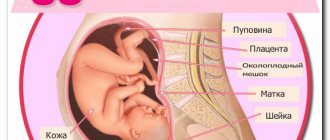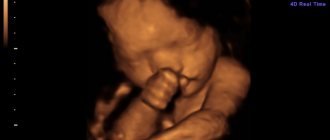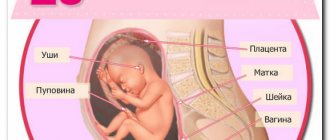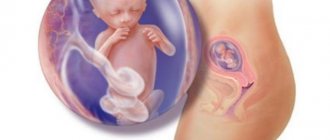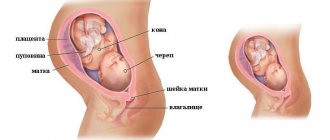The 28th week of pregnancy is also called the beginning of the last trimester. Most of the waiting is over. But by this time, new worries arise in the expectant mother, because the day of the upcoming birth is getting closer. During this period, a pregnant woman needs support from loved ones, relatives, as well as a highly qualified obstetrician-gynecologist. The doctor will reassure the expectant mother, explaining all the changes in her body, advise, and take the necessary actions to prevent complications that arise.
Condition of a pregnant woman at the start of the third trimester
What will the expectant mother remember about the 28th week of pregnancy? At the beginning of the last trimester, the fetus has developed most of its systems and internal organs, but it is not yet considered full-term. If this happens and there is a premature birth, then with the current level of medical care, with a high degree of probability the child will be delivered. However, it is better for the mother to avoid negative thoughts and wait for the baby on the due date.
What happens to the child during this period?
Normally, on an ultrasound scan at 28 weeks of pregnancy, the baby has the following dimensions:
- height – 34-37 cm;
- weight – 1-1.2 kg.
At this stage there is already a subcutaneous fat layer. There is further improvement of internal organs and systems:
- external lubricant appears, which protects the baby’s skin from swelling due to constant presence in the amniotic fluid;
- the fetus begins to blink, because eyelid muscles appear;
- the lungs continue to develop in preparation for childbirth;
- the adrenal glands produce hormones;
- grasping and sucking reflexes appear;
- the skin becomes smooth and soft;
- eyelashes become longer, a pigment appears that colors the hair;
- strength appears in fully developed muscles;
- bones become harder, calcium accumulates in them;
- convolutions and grooves in the brain are improved.
The pulmonary alveoli interact with the blood vessels, preparing the child to breathe on his own. He is already making attempts to do this, but swallows the amniotic fluid. At the same time, the woman feels rhythmic tremors in her stomach, as if the fetus is hiccupping.
The baby may respond to the mother's voice with a rapid heartbeat. When he sleeps, his heart rate evens out. With sharp sounds, the fetus shudders, and loud ones make it actively move. By the end of the 28th week he should be cephalic.
Mode
Any doctor will recommend walking and resting more during this period, since many pregnant women during this period begin to feel more tired and short of breath. The load in the mother’s body due to the weight of the fetus, placenta, and amniotic fluid increases several times. If a woman is still working and has not gone on prenatal leave, then it becomes difficult for her to get to the place and travel by transport.
When the 28th week of pregnancy arrives, it is time to start wearing a bandage, if the mother has not put it on before. The recommendation is due to the fact that the child is actively growing, the load on tissues and ligaments increases. A bandage prevents micro-tears (stretch marks) in the skin and makes it possible to reduce the load on the spine. The bandage supports the abdomen quite well, but it cannot be worn constantly. Correctly put on and take off in a horizontal position.
It’s good if by the beginning of the 3rd trimester the baby is already lying correctly, head down. But it also happens differently, however, he still has time to turn around.
Preparing for an ultrasound
Special preparation of a pregnant woman for the study is not required. She needs to prepare with her napkins, a diaper (a towel is possible) and documents (passport, SNILS, insurance policy and medical card with all the results of previous examinations). If the procedure is carried out in a private clinic, the woman will often not need a diaper or napkins with her; disposable ones are available there. Some pregnant women, knowing that they will have to stand in line for a long time, take water and a snack with them.
Legumes cause bloating, you shouldn’t eat them before an ultrasound
Before an ultrasound examination, a woman is not recommended to consume foods that cause gas formation for several days. Sometimes pregnant women, before going for the procedure, take some kind of drug that relieves flatulence. High gas production leads to blurred images.
Nutrition for a pregnant woman in the 3rd trimester
Mothers may experience heartburn at this stage of pregnancy. What is this connected with? The height of the uterine fundus becomes between 26 and 31 cm.
An interesting fact to note: the height of the uterine fundus is approximately equal to the term.
Due to the growth of the fetus in the uterus, the abdominal organs change their position, including the stomach. It moves slightly in relation to the esophagus and, as a result, the locking sphincter muscle relaxes and the contents of the stomach periodically enter the esophageal mucosa. In this regard, a pregnant woman’s meals should be fractional, and the serving size should be small. It is better to eat more often, but little by little.
A pregnant woman's menu should be quite varied. It includes a significant proportion of proteins, carbohydrates that take a long time to digest, healthy fats, vitamins, grains and herbs. If a mother leans on easily digestible chocolate bars or fatty foods, then this will not have the best effect on both her figure and the health of the fetus. In addition, a complex of vitamins and minerals is considered mandatory, especially when eating in a big city.
A woman expecting a baby does not need to drink a lot of liquid for two reasons: firstly, it provokes swelling of the extremities, and secondly, it increases the already heavy load on the urinary system.
Swelling can lead to the fact that mothers will have to choose not only comfortable, but also larger shoes. It is better to choose clothes without putting pressure on your stomach.
Possible problems
Pain
Along with the growth of the fetus, the body weight of a pregnant woman also increases, which leads to unpleasant painful sensations in various parts of the body. For the most part, the pain goes away quickly. If they bother a woman more and more often and intensify, then she should definitely see a doctor.
- Lower back pain is caused by a shift in the center of gravity and increased stress on the muscles and ligaments of the back. Sharp and jerky pains that often occur during premature birth are dangerous.
- Pain in the lower abdomen and hypochondrium can be disturbing due to excessive activity of the child. As a rule, the discomfort goes away as soon as the baby takes a comfortable position. However, if the pain intensifies, nausea, vomiting and lack of appetite are observed, then this may be urolithiasis. Urgent consultation with a specialist is needed.
- Leg pain is caused by swelling. The 28th obstetric week of pregnancy is a period when the amount of fluid in a woman’s body sharply increases due to an increase in the volume of amniotic fluid and the mother’s increased need for plenty of fluids. If fluid accumulation is not controlled and causes severe discomfort and even pain, this is a problem that can cause complications. The most common include varicose veins in the legs and late toxicosis (preeclampsia). With gestosis, a pregnant woman suffers from severe swelling and high blood pressure. The expectant mother constantly feels nauseous, suffers from dizziness and ringing in the ears.
Discharge at the 28th obstetric week
At week 28, you should be careful about your discharge. If they have a uniform consistency, a whitish color and a slightly sour smell, this is normal. If the smell has become pungent, streaks of pus or blood have appeared, then this is an alarming sign of infection in the genital tract. The first step is to visit a doctor to diagnose and treat the disease.
Watery discharge may signal the onset of premature labor. If there is a large outpouring of water, it is necessary to urgently call doctors who will hospitalize the pregnant woman.
If fluid is released in small quantities, it is best to immediately inform your gynecologist. The doctor will examine the patient and determine whether preterm birth can be prevented.
Uterus at 28 weeks of pregnancy
The height of the uterine fundus is on average 28 cm. The gynecologist measures this indicator at each appointment to ensure the correct development of the child. The walls of the uterus stretch as the fetus grows until the moment of birth.
- The expectant mother periodically feels tension in the muscles of the uterus. These are Braxton Hicks contractions, which prepare the uterus for labor. Normally, they last no more than 1-2 minutes, do not intensify and do not cause severe discomfort.
- The uterus, increasing in size, displaces nearby organs, primarily the stomach and bladder. As a result, the urge to urinate appears more and more often; many mothers have to go to the restroom even at night. Due to compression of the esophagus, gastric juice enters it, causing heartburn and indigestion.
- Weakness and dizziness may occur, especially after resting in a supine position. Sleeping in this position is not recommended: the heavy uterus puts pressure on the vena cava, which supplies blood from the lower body to the heart. This leads to a sharp decrease in blood pressure, which can cause a woman to faint.
Bleeding
In the early stages of pregnancy, bleeding is a sign of an unfavorable pregnancy, which can lead to miscarriage. In the third trimester, sudden vaginal bleeding is no less dangerous. They say that complications develop in the expectant mother’s body, which may include:
- placenta previa;
- premature detachment of the placental sac;
- uterine fibroids or cervical erosion.
Whatever the reason, if bleeding occurs, you should immediately call a doctor. A pregnant woman needs urgent hospitalization and, in some cases, surgery (caesarean section).
Analyzes
At the 28th week of pregnancy, routine examinations of the condition of the pregnant woman and the fetus are carried out, such as a general blood and urine test. The observing doctor monitors the level of sugar and hemoglobin in the blood results, and it is important not to miss the presence of protein in the urine test data.
Protein in the urine along with edema may indicate the onset of late gestosis, an extremely dangerous condition for a woman!
Using a centimeter tape, measure the height of the uterine fundus and abdominal circumference. Listens to the baby's heartbeat and measures the mother's blood pressure.
Routine ultrasound of the fetus at 28–29 weeks of pregnancy is not provided. However, it happens that you need to do ultrasound diagnostics according to indications. Ultrasound is especially often prescribed to assess the condition of the placenta or the degree of entanglement of the umbilical cord. In this case, the woman is given a referral to an ultrasound scanner (ultrasound). They pass it without filling the bladder. The level of hCG at this stage in pregnant women no longer increases; it is in the range of 2700–78100 mU/ml.
At the 28th week of pregnancy, routine examinations of the condition of the pregnant woman and the fetus are carried out, such as a general blood and urine test. The observing doctor monitors the level of sugar and hemoglobin in the blood results, and it is important not to miss the presence of protein in the urine test data.
Protein in the urine along with edema may indicate the onset of late gestosis, an extremely dangerous condition for a woman!
Using a centimeter tape, measure the height of the uterine fundus and abdominal circumference. Listens to the baby's heartbeat and measures the mother's blood pressure.
Routine ultrasound of the fetus at 28–29 weeks of pregnancy is not provided. However, it happens that you need to do ultrasound diagnostics according to indications. Ultrasound is especially often prescribed to assess the condition of the placenta or the degree of entanglement of the umbilical cord. In this case, the woman is given a referral to an ultrasound scanner (ultrasound). They pass it without filling the bladder. The level of hCG at this stage in pregnant women no longer increases; it is in the range of 2700–78100 mU/ml.
Childbirth at 28 weeks
It is at the 28th week that if the course of pregnancy is unfavorable, the risk of premature birth is likely. What are the consequences, will it be possible to save the child’s life? It is impossible to answer this question unequivocally, but the level of modern medicine is high enough to help a baby who was born prematurely. The fetus itself can already exist outside the mother's womb, subject to proper care. According to statistics, in most cases, premature birth ends positively for the child; deaths are rarely recorded.
As for the mother’s body, it experiences serious shocks. Premature birth is complicated by the fact that the birth canal is not ready to receive a baby, there are no regular contractions and, as a result, extensive bleeding occurs. Recovery from a premature birth, unlike a full-term birth, will be long and difficult. That is why gynecologists do everything in their power to prevent the early birth of a child.
Baby's movements
Fetal activity in weeks 28–29 is high. The baby's movements become noticeable, but you still need to make sure that they are regular. A mother should feel her baby at least 10 times per hour. The easiest way to feel the movement is if you eat a little sweet, because the baby can already distinguish the taste. It also helps to lie on the bed in a calm state and stroke your stomach.
Training contractions
At this stage, false contractions may already occur, in the form of tension in the uterus for some time. In medicine, they are called Braxton Hicks contractions. They can be distinguished from real ones by the fact that the interval between them does not shorten, pain does not occur, and they do not provoke the rupture of amniotic fluid. A false contraction does not last long, from 30 seconds to a minute. Training contractions are scary for pregnant women, but they are very important for the upcoming birth. Contractive movements tune and tone the muscle fibers of the uterus for the upcoming labor.
Nutrition
Nutrition at 28 weeks of pregnancy
By the 28th week, a pregnant woman increasingly feels the pressure of the uterus on the stomach: heartburn, a feeling of heaviness, and sometimes nausea. To minimize discomfort, it is recommended to follow simple nutritional rules:
- eat a little, but often. It is ideal to divide the daily diet into 5-6 meals;
- don't overeat. Finish your meal until you feel full;
- try not to combine several dishes in one meal;
- distribute the necessary products throughout the day: have breakfast with porridge, after 3 hours have a snack with vegetables or fruits, dried fruits or nuts. For lunch, give preference to protein foods: meat, fish, dairy products, eggs. For dinner, it is advisable to choose light food;
- try to eat in the evening 2-3 hours before bedtime, if necessary, eat an apple or yogurt before bedtime;
- Monitor sufficient fluid intake. If the gynecologist has not indicated the possible daily volume, you should adhere to the norm of 2 liters;
- avoid harmful foods and semi-finished products, completely eliminate alcohol;
- in the absence of a recommendation from a gynecologist, completely eliminate strong tea and coffee;
- monitor the amount of salt consumed. Ideally, the total amount of salt consumed during the day does not exceed 1 g.
Vitamins
Taking multivitamin complexes and dietary supplements at the 28th week of pregnancy should be strictly as prescribed by the gynecologist. It is important to monitor compliance with the dosage and the characteristics of taking the prescribed vitamin complex.
The ideal option is to obtain all the necessary nutrients from food, and use dietary supplements as an additional method of fortification.
How does the baby look on an ultrasound at the beginning of the third trimester?
Despite the fact that the 28th week of pregnancy does not require ultrasound diagnostics, if you look at what the baby does at this stage, you can see that he opens and closes his eyes. His eyelashes begin to grow, and they will grow the most in the first three months after birth. He can feel his body with his hands and touch the umbilical cord. As for sounds, he can already hear even not very loud sounds, not to mention screams. On them he can wince and turn. It distinguishes the voice of the mother, and if the father is often nearby, then the father.
Cold treatment
At twenty-eight weeks of pregnancy, a cold does not pose such a threat to the baby as in earlier stages, but this only applies to ordinary ARVI. If cough, nasal congestion and fever appear due to diseases such as rubella or chickenpox, the woman needs urgent medical attention.
What to do if you have a common cold:
- It is recommended to treat a runny nose by rinsing the nose with saline solution;
- Mint candies or warm tea with honey will help with a sore throat;
- For fever you can take Paracetamol.
A pregnant woman needs to rest more and drink plenty of fluids. If your temperature rises to high levels or other alarming symptoms appear, you should immediately consult a doctor.
Fruit size
What is the anatomical development of the fetus at 28–29 weeks of gestation? On an ultrasound, you can see and measure that the total length of the child’s head, torso and legs is about 37–38 cm, and the weight of the fetus at 28–29 weeks is approximately 1120 to 1220 grams. Moreover, it is considered normal that boys can be slightly larger than girls. Other fetal sizes that ultrasound can show:
- BPR (biparietal head size) – 70.5 mm;
- OG (head circumference) – 260–273 mm;
- Coolant (abdominal circumference) – 227–235 mm;
- SDG (average chest diameter) – 71.9 mm;
- DZ (abdominal diameter) – 73.5 mm;
- Thigh length – 53 mm.
Fetometry
This section includes a large number of measured indicators that are important for diagnosing most types of pathology.
Table of fetometric parameters in the twenty-eighth week of pregnancy.
| Fetomeric indicator | Standard values, mm | ||
| 5th percentile | 50th percentile | 95th percentile | |
| Biparietal head size | 67,2 | 72,8 | 79,1 |
| Fronto-occipital size | 83,1 | 91,3 | 99,6 |
| Femur length | 48,9 | 53,2 | 58,2 |
| Shin length | 44,8 | 49,1 | 54,1 |
| Humerus Length | 45,5 | 48,7 | 52,9 |
| Length of forearm bones | 39,2 | 42,9 | 47,2 |
| Abdominal circumference | 216,9 | 241,2 | 264,9 |
| Head circumference | 244,5 | 265,3 | 284,7 |
All fetometric indicators are of general importance for assessing fetal development, diagnosing intrauterine growth retardation and its type. When changing, the correct choice of projection and repeated measurements are important. When assessing the length of bones, all measurements must be taken symmetrically on both sides. This will allow you not to miss unilateral aplasia and hypoplasia of the limbs. If, due to the position of the child, visualization of the arms and legs on both sides is difficult, then this should be reflected in the protocol.
Internal organs
At this time, if they do look at an ultrasound, they carefully analyze the volume of amniotic fluid, the maturity of the placenta, the number of vessels in the umbilical cord, and the functioning of the baby’s heart. In some cases, the fetal heart is sent separately for ultrasound. HR (heart rate) should be in the range of 130–160 beats per minute. All chambers of the heart should be clearly visible on the ultrasound scanner.
Psychologically, the mother is already preparing for childbirth, so everything connected with the baby and the upcoming birth calms her down. Some experience “nesting” syndrome and have a desire to clean up the apartment, make repairs, and equip the nursery. The 28th week of pregnancy is a good time to decide on the choice of maternity hospital and prepare a dowry for the child.
The 28th week of pregnancy marks the transition to the third and final trimester. There is not much time left before giving birth. Therefore, taking care of the child and yourself should come first, and leave work for later.
Detectable pathology
The period of 28 weeks is not optimal for searching for developmental anomalies, however, if previous studies have not been performed or their quality is poor, it is possible to identify some anomalies.
Intrauterine growth restriction
When intrauterine development is disrupted, there are two forms:
- symmetrical, which is characterized by a delay in the growth and weight of the fetus at the same time. This form is rare at 28 weeks.
- the asymmetrical form occurs when the child’s body length corresponds to the term, but there is a weight deficit that develops against the background of uteroplacental disorders or severe extragenital (non-gynecological) pathology of the pregnant woman. Most often occurs at the end of the second and during the third trimester.
Bone dysplasia
Among bone anomalies, the most common are hypoplasia and polydactyly. To diagnose hypoplasia and aplasia of limb bones, it is important to take measurements on both sides and during each ultrasound examination. Polydactyly can occur on the upper and lower extremities, or it can be combined. When diagnosing this pathology, amniocentesis is recommended to exclude chromosomal abnormalities, since extra fingers are often one of the symptoms of disorders at the gene level.
Pathology of internal organs
In the diagnosis of most defects, ultrasound examination at 28 weeks is of auxiliary value. By this period of pregnancy, two screening studies have already been carried out, during which the main pathology is revealed. Even anomalies detected for the first time at this stage do not affect the management of pregnancy, but can only be reflected in the postpartum management of the child.
In case of previously identified pathology, diagnosis at this time is only a confirmatory stage.
For decades, ultrasound has been helping in prenatal diagnosis and pregnancy management. During this time, principles and criteria were formed, as well as optimal scanning times. Therefore, it is necessary to visit a doctor within the prescribed period to obtain the most accurate information in a timely manner. Week 28. Diagnostics at 28 weeks is only of an auxiliary nature and should be carried out in rare cases if there are individual indications.
